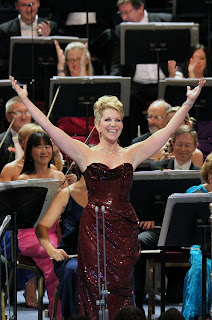Men have been doing it since 1894, when Frank Wedekind first shocked the world with his Lulu play(s) about an amoral child-woman abused by men and doing what she can - which turns out not to be much - to get her own back. At least Wedekind had the half-decency to wonder whether (spoiler alert) Jack the Ripper should casually slaughter Lulu's lesbian admirer Countess Geschwitz on the way out of her garret; Geschwitz did survive in Christof Loy's mesmerising, minimalist Royal Opera production of Berg's operatic version.
Now a woman who ought to know better joins the persecution. Composer Olga Neuwirth (second spoiler, if you're really determined to go see her version) has her Lulu shot by ALL the men in her life. But much, much worse, in American Lulu, a 'version' unwisely taken on by director John Fulljames and a committed company now playing at the Young Vic, Neuwirth murders her protagonist with the most inept, incoherent replacement imaginable for the last act Berg, in his mostly compassionate character-study, failed to complete.
Neuwirth (pictured above; happy to give the credit, unsupplied on my source) writes that she finds the opera's ending, as completed by Friederich Cerha and accepted these days by most opera houses, unsatisfactory. But it's Wedekind's as well as Berg's, and of course the symmetry is essential: Lulu's earlier 'victims' all return in different guises as her clients, and Dr Schön, the only man she says she ever loved, is 'Jack'. In any case, about 12 minutes of the music, including the crucial Liebestod, is already there in Berg's Lulu-Suite.
But no, Neuwirth, having slashed and burned the first two acts to virtual incoherence - the audience was already leaving the theatre in droves midway through the performance I saw - writes her own jangly, vocally awkward and high-lying muzak for all but a bar or two of an intolerable last third (we're held captive for an intervalless hour and forty minutes, though that didn't stop the escapees). In her favour are the Morton Wender organ arrangements of the jazz music and the central, palindromic interlude - but the animation narrative to that, by the usually excellent Finn Ross, is incomprehensible. Unfortunately Neuwirth's own libretto for the final scenes is the most risibly pretentious as well as unclear I think I've ever come across; pity Jacqui Dankworth as the Geschwitz character, stuck to a mike and delivering banal platitudes in a last-ditch attempt for her character to make any kind of impact.
The transfer to the deep south in the Fifties and Sixties as well as New York in the Seventies - will she overcome? - would probably work fine in a production of the real opera; here the interpolated Martin Luther King and June Jordan texts say nothing about what kind of character, or idea, Lulu is. Exploited she may have been, but she ends up an unsympathetic bitch caught in nebulous situations. The end is an awful long time in coming, but it can't come too soon.
This is all a terrible shame for a singer who acts her socks off and would clearly make an excellent Lulu in 'proper Berg', American soprano Angel Blue. She's the main reason why I bother to write about a mostly wretched evening at all (she's pictured throughout here by Simon Annand for the Young Vic). Blue's Lulu is various, compelling and - most important - she can deliver all the high-wire, coloratura-y stuff, or at least what's left of it in Neuwirth's disembowelment. I felt deeply sorry for her lying there as rapid exits were made by at least a quarter of the audience ( I might suggest at least part of this was due to unfamiliarity with Berg's tough musical language, familiar as it is to so many of us now, on the part of Young Vic regulars). She deserves much better and, in any case, her future is bright.
Among the men, the excellent Paul Curievici works hard and convincingly as the Photographer (Berg's Painter, pictured with Blue's Lulu up top), and Robert Winslade Anderson makes a sleazy and by no means decrepit new character, Clarence, out of Wedekind/Berg's Schigolch. The players of the reduced orchestra - the London Sinfonietta, who ought to be good - lack nuance and phrasing; the volume in the small space is relentless. I won't name the conductor, because I know him and like him. Anyway, I sat with interest through what remained of the Bergian torso (no arms either). Towards the end, though, I and my companion, Alexandra Coghlan who's written a very flavoursome review of the show for The Arts Desk*, were screaming for release.
Let's turn, then, to a happier Muse. Anyone who's been reading this blog for long knows how I worship at the shrine of the unique Anne Schwanewilms. At last, in June, I got to hear her ideal Marschallin in Dresden, and she was back here the Monday before last to give a BBC Lunchtime Recital at the Wigmore Hall. I reviewed it for The Arts Desk, and the Schumann Op. 39 Liederkreis knocked me for six. It's now definitively my favourite of all song-cycles (or song groups, if you prefer). I ordered up the Capriccio CD double quick, and tried to play the Schumann half while attending to administrative stuff a couple of days ago.
It's a measure of how Schwanewilms has blossomed from just an otherworldly-beautiful voice to an utterly compelling interpreter that I couldn't just pay half-attention. Every note, every colour demands full focus. The scary wood and castle narratives are searing and 'Wehmut', which Prokofiev adapted with profound significance in the slow movement of his Seventh Piano Sonata, pierces the soul. For me, this is one of the greatest of all Lieder, and Schwanwilms' performance the track I'd now single out for anyone who wants to understand the art in three minutes.
Many of the Wolf songs on the disc were new to me. How strange, unpredictable and unorthodox many are. I must say I don't find the more anguished ones exactly sympathetic or quite human, with the exception of 'Das verlassene Mägdlein' - ach, the pain our soprano brings to 'Träne auf Träne' - but Schwanewilms makes the most of their oddities. Like Schumann, with the added experience of Wagnerian chromaticism backing him up, Wolf can cloud a happy picture so subtly: 'Im Frühling' is the most complex response to spring I know, and what a great scena this makes for Schwanewilms.
I think I like Wolf best when he gives this mesmerising singer the cue to spin a longer line, as in the harmonic miracles of 'Gesang Weylas' and the bright-to-dark 'Verborgenheit'. At any rate, I feel a Wolf obsession coming on: over to Fischer-Dieskau soonest.
Schwanewilms' perfectly good pianist, Manuel Lange, seems rather too ordinary for her. The partners we've seen her with here - Charles Spencer and now Roger Vignoles - seemed much more like equals in strange adventures. A shame, in the meantime, that there's no complete single Wolf or Schumann song from Schwanewilms on YouTube. What I did find is this interview, introduced in English but not thereafter subtitled. It includes, piecemeal, the performances of Wolf's 'Auf einer Wanderung' and 'Das verlassene Mägdlein'.
And here's some wonderful news: sorry as I am that fine Lieder singer Angelika Kirchschlager has had to withdraw from this coming Thursday's Wigmore recital, it's fabulous that Schwanewilms, with Spencer, will take her place. Not sure how much of the programme I can catch given that I have to be at a short concert to inaugurate the Barbican/Guildhall School of Music and Drama's Milton Court; Debussy, Strauss and Wolf may be casualites, but I'm assuming Wagner's Wesendonck Lieder will be the last songs on the programme, and I wouldn't miss what Schwanewilms makes of them for the world.
Coda should belong to a third soprano of the front rank, gifted Anna Prohaska, singing Lied der Lulu from Berg's suite under Abbado. I was lucky enough to catch this most potent of teams at the Lucerne Easter Festival several years ago, when the orchestra was not the Berlin Phil, as here, but the Simón Bolívar [no longer] Youth Orchestra. It was their first acquaintance with Berg, and could the touch have been more incandescent than Abbado's? He creates his sound no matter who he conducts. So it was with the Venezuelans, and so it is here with the Berliners. Text of Lulu's Credo as applied to Doctor Schön follows.
Although for my sake a man may kill himself or kill others, my value still remains what it was. You know the reason why you wanted to be my husband, and I know my reasons for hoping we should be married. You let your best friends be cheated by what you made me, yet you can't consider yourself caught in your own deception. Just as you've given me the evening of your life, so you've had my whole youth in exchange. I've never sought in my life to appear other than the image which has been created of me. And no-one has ever taken me for anything other than what I am.
*Poor Alexandra - what a week she's had of it. Hard to tell which she disliked more, this - probably, given the single star - the Grandage A Midsummer Night's Dream or the oldies' Much Ado About Nothing. Add into the mix Matt Wolf's hilarious review of the film Diana, and it's been a week of serious thumbs-downing on The Arts Desk. Except from me for Mitsuko and young maestro Robin on Thursday.












































































